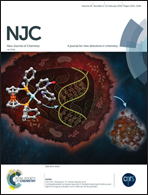Diverse chemistry of the dianion [closo-B9H9]2−: synthesis and reactivity of its mono-anionic derivative [arachno-B9H12-4,8-Cl2]−†
Abstract
Attempted protonation of the dianion [closo-B9H9]2− under moisture-free conditions did not afford its mono-protonated form [closo-B9H10]−. The reaction of the former closo-borate with CH3COOH in dichloromethane yielded a monoanionic product [B2O(MeCO2)5]−. The treatment of [closo-B9H9]2− with HCl in dichloromethane afforded its arachno-derivative [arachno-B9H12-4,8-Cl2]− in a high yield. The experimental solution and quantum-chemically calculated 11B and 1H NMR spectra of the latter monoanion were found to be in a good agreement; its structure in the solid state was studied by the single crystal X-ray diffraction experiment for the crystal (PPh4)[arachno-B9H12-4,8-Cl2]·0.04HCl. The reaction of [arachno-B9H12-4,8-Cl2]− with liquid ammonia caused its quantitative conversion into the parent [closo-B9H9]2−.
![Graphical abstract: Diverse chemistry of the dianion [closo-B9H9]2−: synthesis and reactivity of its mono-anionic derivative [arachno-B9H12-4,8-Cl2]−](/en/Image/Get?imageInfo.ImageType=GA&imageInfo.ImageIdentifier.ManuscriptID=C7NJ04251E&imageInfo.ImageIdentifier.Year=2018)


 Please wait while we load your content...
Please wait while we load your content...